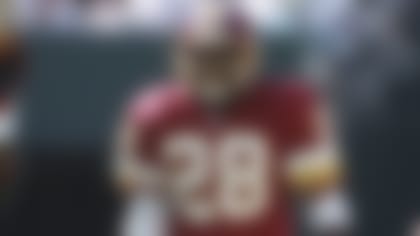As the draft approaches, scouts and coaches are making the rounds to visit various college campuses for pro days.
These workouts represent the final opportunity for some of these players to impress decision makers with their athleticism and overall skills.
For scouts and coaches, they provide an opportunity to find answers for some of the burning questions that are floating around various war rooms.
With more workouts scheduled for this week, let's take a look at five questions that are in play for front offices around the league:
1. Is Clausen a franchise quarterback?
That is the question that several franchises are pondering as draft day approaches, and the answer could ultimately alter the landscape of the first round.
Top 25 draft prospects
While Tim Tebow is not one of Bucky Brooks' top prospects, fellow quarterbacks Sam Bradford and Jimmy Clausen are among the best 25 heading into April's draft. **More ...**
Jimmy Clausen, who entered the draft after passing for 3,722 yards with 28 touchdowns and only four interceptions during his junior season at Notre Dame, is widely regarded as the second-best quarterback available in the draft. He is considered a pro-ready signal caller based on his three years of experience directing Charlie Weis' offense.
Although the Fighting Irish didn't enjoy tremendous success in the victory column with Clausen at the helm, the experience of directing a conventional two-back offense has ultimately prepared him for playing the game on Sundays.
Unlike most of the quarterbacks in this year's draft, Clausen has spent countless hours learning how to play the position in a conventional manner. This includes taking snaps from under center and throwing a variety of drop-back and play-action passes. That gives him a leg up on most of the competition, because he understands how to locate his reads after turning his back to the defense while executing run fakes.
Additionally, he will enter the league well schooled on the footwork and mechanics needed to throw passes off three-, five- and seven-step drops. Those fundamentals wouldn't appear to be a major issue for an upper echelon quarterback prospect, but they are becoming increasingly important due to the proliferation of the spread offense on the collegiate level.
Most major colleges run some form of the wide-open scheme, and a brief look at the top quarterbacks available in this year's draft highlights the overwhelming presence of the spread. Oklahoma's Sam Bradford, Texas' Colt McCoy, Florida's Tim Tebow and Cincinnati's Tony Pike all starred in spread offenses, and their perceived struggles to acclimate to the pro game have undoubtedly elevated Clausen's stock in the scouting community.
While his arm strength and accuracy have been cited as his biggest flaws, Clausen's savvy and poise has earned him high marks from scouts. In addition, they have been impressed with his ability to make critical plays down the stretch while leading his team to a handful of come-from-behind wins.
Although his leadership skills and attitude have been called into question by some, the cocky quarterback has seemingly answered those concerns by conducting solid interviews with general managers and coaches during the NFL Scouting Combine. Given the importance of confidence and self-assurance at the position, Clausen's brash demeanor can be perceived as part of the inherent swagger needed to man the game's most important position.
Given Clausen's experience in a pro-style offense and his solid skills at the position, he is a sure first0-round pick poised to be selected at some point in the draft's opening stanza.
Whether he has the potential to develop into a franchise quarterback in the mold of Mark Sanchez or Joe Flacco will ultimately determine how quickly Clausen hears his name called on draft day.
2. Will Spikes' poor 40-yard dash time drop him?
Florida linebacker Brandon Spikes is regarded as one of the top players at the position, but his disappointing 40-time will lead to a drastic drop down the charts on draft day.
Spikes, who was viewed by most scouts as a second-round projection after a stellar career at Florida, posted 40 times in the 5.05- to 5.10-second range, and didn't show any explosiveness or burst while performing the other agility drills during the workout. Although these drills aren't always an accurate indicator of a prospect's ability, evaluators have a tough time pulling the trigger on an inside linebacker who runs slower than 4.8 in the 40.
In their minds, a slow linebacker lacks the athleticism to stay on the field as a "three-down linebacker," and some teams refuse to use an early-round selection on a player with severe limitations.
Spikes, however, is one of the most instinctive players at the position, and his exceptional awareness allows him to be a playmaker against the run or pass. With six career interceptions, including four returned for touchdowns, Spikes has skills that exceed his disappointing measurables.
Scouts often talk about the game tape being the ultimate judge of talent, but the impact of 40-times and other agility drills often cloud the assessment of draft hopefuls. In watching the plight of Spikes, we will soon see if the game tape or the 40-time carries more weight in the evaluation process.
3. Why is Bryant dropping?
Oklahoma State's Dez Bryant has widely been regarded as the most talented receiver in the 2010 draft class, but he has seen his value dip significantly in recent weeks.
Teams have growing concerns about his character, and their apprehension has resulted in Bryant falling to the bottom of the first round on several draft boards across the league.
Bryant, who missed 10 games in 2009 after being suspended by the NCAA for lying to an investigator, reportedly comes with a host of emotional baggage after growing up in a difficult situation, and scouts are worried about how that will impact his ability to focus on the field.
Additionally, scouts are starting to question Bryant's speed after watching his tape. Though most scouts estimate that Bryant will clock a 40-time in the mid-4.5 range, reports are buzzing that he will fail to crack the 4.6 mark. Although a receiver of Bryant's stature is not expected to post a sizzling time, a slow clocking will lead to some questions about his big-play potential, despite evidence to the contrary on tape.
Bryant is still clinging to his spot at the top of the receiver chart, but he will need an impressive performance at his pro day, and a strong series of interviews on team visits, to secure a spot in the middle of the first round.
4. Will hybrids still be the rage in 2010?
The growing popularity of the 3-4 is having a tremendous effect on the draft, as more teams are looking for hybrid rushers to anchor their defense. These hybrids (former 4-3 college defensive ends converted to 3-4 outside linebackers) are coveted for their ability to rush the passer, while also possessing the athleticism to drop into coverage.
Last year, five hybrids (the Bills' Aaron Maybin, the Redskins' Brian Orakpo, the Chargers' Larry English, the Broncos' Robert Ayers and the Packers' Clay Matthews) went in the first round, and two (Orakpo and Matthews) earned Pro Bowl honors during their rookie seasons.
Given their ability to impact the game as a rusher or dropper, these versatile playmakers have enormous value on draft day, and that is likely to continue in the 2010 NFL Draft with as many as 12 teams using a 3-4 as their base scheme.
In looking at this year's draft class, the hybrid position isn't as deep as last year's group, but has outstanding talent at the top of the class. Texas' Sergio Kindle, Michigan's Brandon Graham and TCU's Jerry Hughes headline the first-round hopefuls that are poised to make an immediate impact. Utah's Koa Misi, Ohio State's Thaddeus Gibson and Clemson's Ricky Sapp may join them as early-round selections in April.
With sacks and takeaways ranking as priorities for teams employing the 3-4, the need for explosive edge players in the lineup continues to be a must, and the 2010 NFL Draft will provide them with plenty of options in the early rounds.
5. Who is Rodger Saffold?
One of the hottest prospects in the draft is Indiana's Rodger Saffold. The offensive tackle has shot up draft boards in recent weeks, and is pushing for first-round consideration.
As a rough, rugged blocker with good strength and power, Saffold is an exceptional run blocker capable of moving defenders off the ball. He plays with a good motor and shows a willingness to finish his blocks after making initial contact. In pass protection, Saffold has quick feet and does a good job of using his superior arm length to keep rushers at bay. Though he struggles occasionally against the bull rush, he shows the balance and body control to anchor against powerful edge rushers.
With as many as four offensive tackles slated to go in the top half of the first round, Saffold is one of the offensive tackles who could be targeted by teams at the bottom of the round in desperate need of a quality pass protector.





